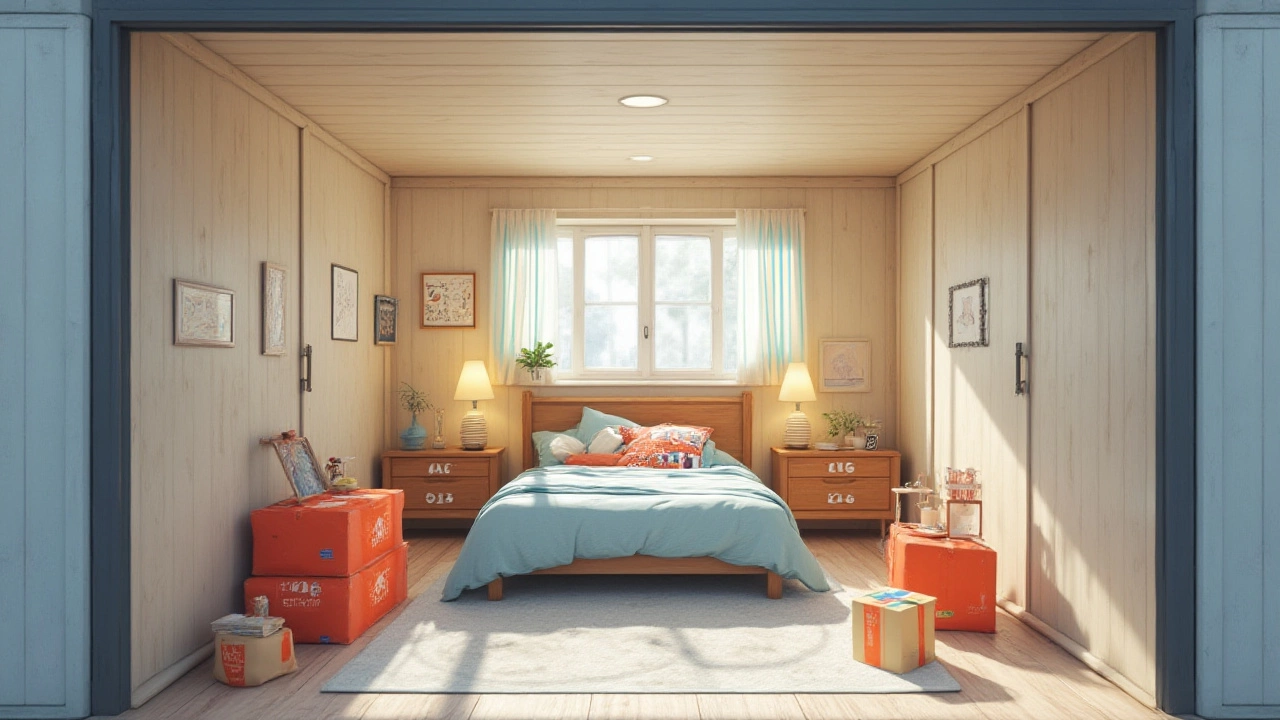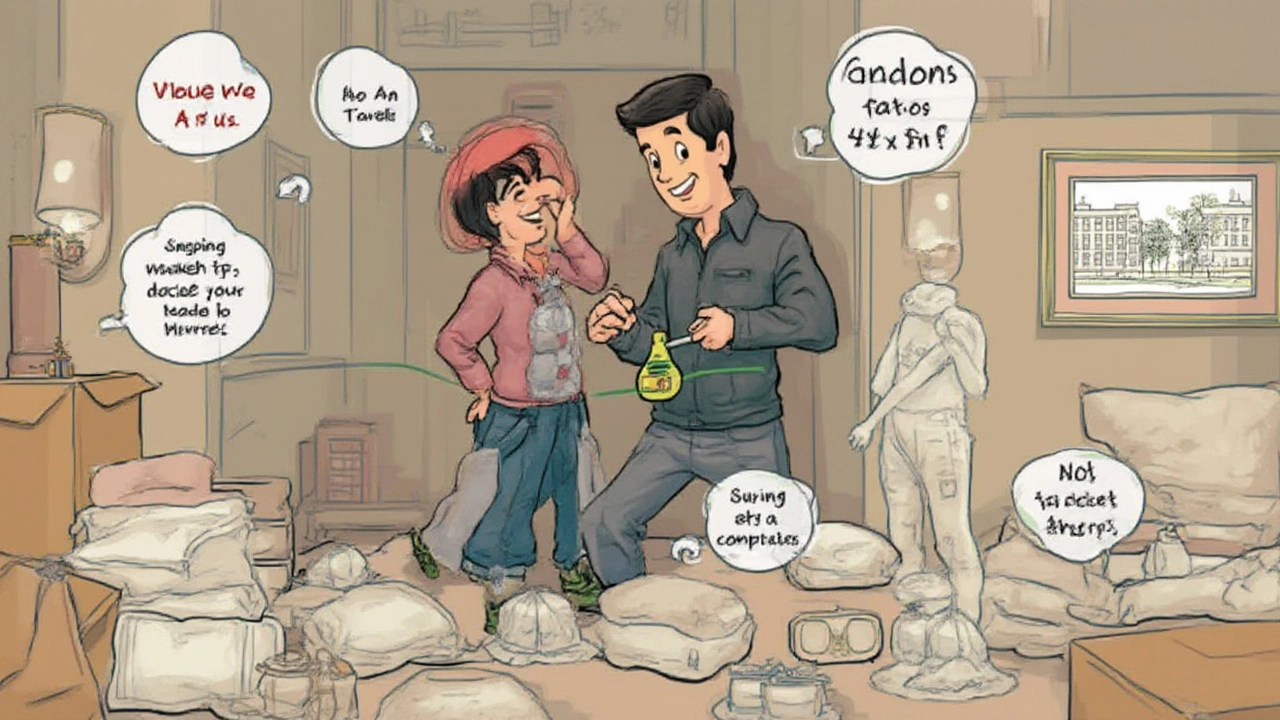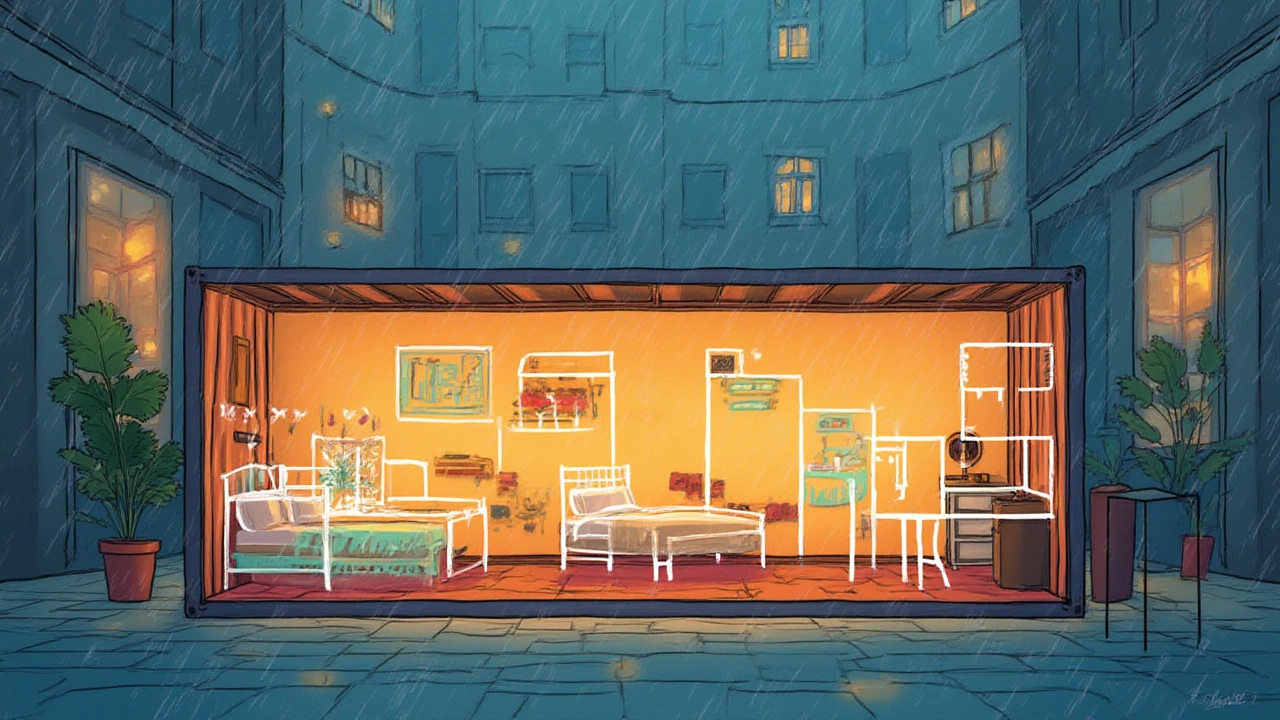How Many Bedrooms Fit in a 10x10 Storage Unit? Space, Beds, and Smart Solutions
 Jul, 20 2025
Jul, 20 2025
People love to overestimate space – until you’re standing in an empty, echoey 10x10 storage unit, wondering if your whole bedroom, or maybe two, could fit inside without ending in an epic game of mattress Jenga. Don’t just guess; get the real details before you lug half your house into storage or try to create a temporary bedroom during a renovation. When I moved a few years ago, I found out that what looks huge empty turns very small in a hurry. And trust me, nothing is as humbling as shoving your king-size bed toward the door, sure it’ll fit because 'it’s only ten feet wide!' Let’s get into the nitty gritty.
Some people browse storage unit websites or ask the manager and get the same answer: 'A 10x10 can fit the contents of two bedrooms!' But is that realistic or pure optimism? Every inch matters here. We’re diving deep into the true capacity of a 10x10 storage unit, exactly how many bedrooms worth of beds and furniture you can cram in, and tricks for making your stuff fit without needing three people to close the door.
How Big Is a 10x10 Storage Unit—Really?
So, what do you really get when you rent a 10x10 storage unit? Here’s the deal: that's 10 feet wide and 10 feet deep, totaling 100 square feet of floor space. Usually, the ceiling hits right around 8 feet high, giving you about 800 cubic feet to play with—on paper. But rooms aren’t made of thin air, and neither is your stuff. Bulky furniture eats space much faster than you’d think. Drag in a queen bed, nightstands, a dresser, and you’ll notice it fills up faster than Dorian’s closet during a back-to-school sale.
Most US bedrooms, especially in suburban houses or newer apartments, run somewhere between 10x10 and 12x12 feet themselves. So technically, a 10x10 storage unit is about the size of a modest bedroom. But, without the benefit of wall closets, you’re packing every scrap of clothing, art, decor, spare shoes, and more into the open space.
Picture this: one king-size mattress is about 6.5 feet long and just over 6 feet wide. You might think, “Easy, that’ll fit on the floor with room to spare.” But stack two or three mattresses, things get trickier. Now bring in bed frames, dressers, lamps, boxes of bedding and clothes, maybe that beanbag Selena won during a school raffle. Suddenly, that 100 square feet is a tight squeeze.
To put it in real-world terms, here’s a quick reference table with standard American bed sizes and how they fit into a 10x10 unit:
| Bed Size | Dimensions (inches) | Dimensions (feet) | Area (sq ft) | Fits Flat in 10x10? |
|---|---|---|---|---|
| Twin | 38 x 75 | 3.17 x 6.25 | ~20 | Yes, multiple |
| Full | 54 x 75 | 4.5 x 6.25 | ~28 | Yes, 2 side by side |
| Queen | 60 x 80 | 5 x 6.67 | ~33 | Yes, 2 tight, no frames |
| King | 76 x 80 | 6.33 x 6.67 | ~42 | Yes, just barely |
Stacking is your friend in storage-land. Move mattresses on their sides and you can fit multiples; keep them flat and you cut your space down quick. Remember, a king mattress set up on its side next to the wall makes space for bikes or boxes next to it. If you bring in bedroom furniture, measure carefully. Even a large dresser chews up valuable square footage. I once stacked Dorian’s twin bunk set and left enough space for two dressers by going vertical. Tricky, but doable with some creative organizing—and muscle.

How Many Bedrooms Can You Actually Fit?
This is the golden question: How many full bedrooms (meaning beds, nightstands, and dressers) can you reasonably fit in a 10x10 storage unit? The answer—like most things in life—is, it depends. Second, it depends on what you mean by "bedroom." Do you mean just the bed? Or all the furniture?
Let’s start with the basics: most storage companies say a 10x10 fits "two full bedrooms" of stuff. That means two queen or full beds, two dressers, two nightstands, a handful of boxes of clothes and personal items, and maybe a lamp or two. But is that being generous?
Think about this breakdown:
- Single bedroom (queen bed): Mattress (on side), bed frame (disassembled), dresser, two nightstands, plus about six large moving boxes.
- Double up: Two beds? Possible if they’re twins or fulls, stacked vertically or stood up. Queen beds take up more space. Two full sets of furniture starts to jam each wall. If you want to keep the mattresses from getting bent, you lose the right-angle stacking option.
- Add kids’ rooms: With twin beds, bunk bed frames, smaller dressers—much simpler. I fit Selena and Dorian’s old bunk, the drawers, all their stuff, and my office desk into one 10x10 (barely).
This theoretical "two bedroom" suggestion works only if you get creative. For example, disassemble all frames, drawers out of dressers, store the mattresses standing up, and tuck boxes in every open pocket of space. 10x10 storage unit space management is like expert-level Tetris, but it can be done. For most people, unless your bedrooms are minimalist—think mattress and a drawer or two—you’ll bump up against the unit’s limits quicker than you’d like.
And let's get honest: if you add boxes of books, electronics, sports stuff, and all that random bedroom junk (you know, the stuff you swore you didn't have until you packed it), it starts getting tight. If you pack only the beds, you can fit four twin/three full/two queen-or-king mattresses in, stacked on sides, with very little else. Add frames and drawers? Now you’re looking at one and a half sets, max.
Your best bet for efficiency:
- Disassemble everything possible.
- Stand mattresses on sides.
- Use dresser drawers to hold small items or linens rather than leaving them empty.
- Fill nightstand interiors with books, lamps, or shoes.
- Stack boxes up, but keep the weight balanced to avoid tipping.
If you’re okay with only having access to things closer to the door, you can cram quite a lot in. But if you’ll need to get at something mid-unit, leave narrow walkways. No surprise: maximizing these units is a lot like fitting your car’s trunk before a long vacation—start with the biggest pieces, tuck boxes where they fit, and leave the bag of snacks right on top.

Tips for Maximizing Your 10x10 Storage Unit
Just because the raw measurements say you can fit two bedrooms doesn't mean you should wing it. Smart packing is the difference between opening your unit and smiling or opening and fighting an avalanche of your belongings. Here are years’ worth of hard-won lessons, kid-tested and parent approved.
- Plan before you pack: Draw a rough diagram of your unit. Think about where big furniture will go first—usually along the back and sides.
- Go vertical: Shelving units, or just careful box-stacking, frees up a surprising amount of floor space. Even cheap stacking shelves from a hardware store help get shoes, electronics, and hobby gear up and off the floor.
- Box size matters: Use small to medium boxes for heavier stuff like books and dishes. Large boxes are for bedding or fluffy clothes. Consistent box sizing makes stacking easier and less like a falling block game.
- Don’t waste dresser space: Use drawers to stash sheets, cords, gadgets—anything small or fragile. Label everything.
- Disassemble furniture: Remove bed legs, take apart frames, tape hardware in labeled bags to the furniture itself. Secure loose parts inside boxes or drawers so nothing gets lost (or becomes a tripping hazard).
- Mattresses matter: If you can lean them, you’ll buy yourself a chunk of real estate for boxes, lamps, even bikes beside them. Never put heavy furniture on top of mattresses—they’ll sag or warp, which becomes obvious when you set it back up at home.
- Leave an aisle: Plan a small path from door to back wall if you’ll need to find stuff later. It stings having to wedge your body past a fortress of boxes to get to your favorite pajamas.
- Inventory as you go: Photos on your phone help you remember where things are months down the line. Dorian once wanted his science kit mid-move; if I hadn’t snapped a pic, I’d have spent hours hunting.
- Cover items that collect dust: Use plastic sheets, tarps, or even old curtains to keep things clean. Storage units aren’t vacuum-sealed. Ask me about washing everything in the unit when we moved out after six months.
- Dehumidify: Use moisture absorbers (cheap ones from hardware stores work fine) to keep fabrics and electronics from getting musty, especially if you’re storing bedding or clothes for more than a season.
A bonus tip: If you need to frequently access different types of items—say, switching out seasonal bedding or sports gear—store them close to the door or in boxes marked “grab next.” Stack stuff by importance, not just by size, and you’ll save yourself some future stress.
So, while a 10x10 unit can technically hold two bedrooms worth of beds and basic furniture, most folks will hit their limit pretty fast if packing everything from two lived-in rooms. You can store four or five beds if you stack them, but leave out the extra stuff. Cramming in all the family photos, spare shoes, kid art, and quirky keepsakes takes up the rest of your puzzle space. The trick is to rethink every bit of dead space—drawers, sides, under and over—and keep the walkways clear enough that you don’t end up buried in boxes. Storage units are like mini, temporary houses for your stuff, and the better you plan, the more comfortable your belongings will “live” until you need them again.